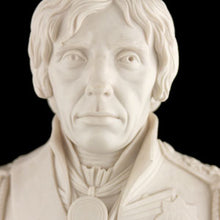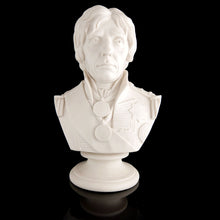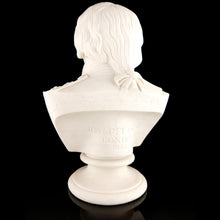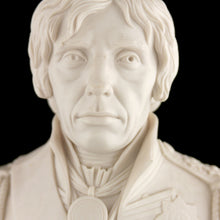Bust of Admiral Lord Nelson, 1853
- Regular price
- £3,900
- Sale price
- £3,900
- Regular price
-
- Unit price
- /per
Adding product to your cart
Height: 24cm (9.4in)
Parian. Vice-Admiral Lord Nelson modelled in vice-admiral’s uniform, with hair en queue and right eye afflicted the blindness sustained during storming of Calvi (Corsica) in 1794 - this emphasized by the deeper drilling of the pupil of his left (good) eye. The reverse inscribed ‘Modeld. under the direction of / Admiral Sir William Parker K.C.B. / from the painting by Wichell in his possession / by JOS.H PITTS. SC / LONDON / 1853’.
The artist Wichell referred to on the the reverse of the present bust is the marine painter John Whichelo (1784-1865) who, by his own account, visited Merton and produced a portrait of Nelson from life shortly before he left to rejoin the Mediterranean Fleet in September 1805. Nelson apparently liked the resulting pastel portrait and favoured it with the same praise he reserved for portrait by Simon de Koster that he considered ‘is most like me’. Many years later in 1838, Whichelo agreed to give drawing lessons to the son of Admiral Sir William Parker (1781-1866), who had served under Nelson during the Trafalgar Campaign as captain of the fifth-rate frigate Amazon. On the day of the first lesson Wichelo presented Admiral Parker with the Nelson portrait he had made thirty years before at Merton. It became a treasured possession of the Parker family, and in 1852 when the sculptor Joseph Pitts modelled a memorial bust of the Duke of Wellington for the Parian producer John Rose & Co. of Coalport, Shropshire, Admiral Parker was moved to demand the same treatment be given to Admiral Lord Nelson using the portrait in his possession. The Parker portrait was sold by Sotheby in July 2013.
Read more
Joseph Pitts (1821-1880) belonged to a London based family of modelers and sculptors. His grandfather was a London silversmith and his father, William (1789-1840) a silver-chaser and modeller who trained at the Royal Academy Schools. Unfortunately his father’s talents as a sculptor gave way to his skill as silver-chaser (he worked on Thomas Stothard’s Wellington Shield, 1814, and John Flaxman’s Shield of Achilles, 1818) and the need to provide for his large family. Ultimately financial worries led him to take a fatal overdose of laudanum in 1840 just as he was about to secure a valuable contract from the London jewellers Mortimer & Hunt. Joseph, along with his elder brothers Thomas and William worked as assistants in their father’s studio from circa 1830 and as such would have been involved in the commission for decorative sculpture at Buckingham Palace. Slow payment for this work forced Pitt’s father to write to the Lords of the Treasury requesting that the balance of £550 be paid for his work at the Palace, claiming that without it ‘I and my family will be ruined’. Joseph similarly would have been involved in the memorial to the self-made millionaire and economist David Ricardo, which though commissioned in marble turned out during restoration in 1870 to be made of composition. In 1839 Joseph’s father unsuccessfully entered the competition for the monument to Lord Nelson in Trafalgar Square. After his father’s death, Joseph exhibited seven works at the Royal Academy between 1842 and 1870. At the census of 1851 Joseph is recorded as a sculptor lodging at the Coalport Inn at Sutton Maddock, Shropshire, indicating he was already working with John Rose & Co., the producers of a hybrid hard paste porcelain since circa 1800.












